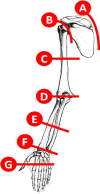Incidence and Characterization of Major Upper-Extremity Amputations in the National Trauma Data Bank
- PMID: 30280131
- PMCID: PMC6145564
- DOI: 10.2106/JBJS.OA.17.00038
Incidence and Characterization of Major Upper-Extremity Amputations in the National Trauma Data Bank
Abstract
Background: There are few recent data examining the epidemiology of severe upper-extremity trauma in non-military patients. We used the National Trauma Data Bank (NTDB) to investigate the epidemiology and descriptive characteristics of upper-extremity amputations in U.S. trauma centers.
Methods: We queried the 2009 to 2012 NTDB research datasets for patients undergoing major upper-extremity amputation and extracted characteristics of the patient population, injury distribution, and treating facilities. In addition, multivariable regression models were fit to identify correlates of reoperation, major in-hospital complications, duration of hospitalization, and in-hospital mortality.
Results: A total of 1,386 patients underwent a major upper-extremity amputation secondary to a trauma-related upper-extremity injury, representing 46 per 100,000 NTDB trauma admissions from 2009 to 2012. The most frequent definitive procedures performed were amputations through the humerus (35%), forearm (30%), and hand (14%). The average duration of hospitalization for all amputees was 17 days. Thirty-one percent of patients underwent at least 1 reoperation. The rate of reoperation was significantly higher at university-associated hospitals compared with nonteaching or community hospitals (p < 0.0001). Patients who had at least 1 reoperation stayed in the hospital approximately 7 days longer than patients who did not undergo reoperation. The Injury Severity Score, hospital teaching status, concomitant neurovascular injury, and occurrence of a complication were significantly associated with reoperation.
Conclusions: The present study provides an updated report on the epidemiology and characteristics of trauma-related major upper-extremity amputation in the U.S. civilian population. Additional work is necessary to assess the long-term outcomes following attempted upper-extremity salvage. The population-level data provided by the present study may help to inform the design and implementation of future studies on the optimum treatment for this survivable but life-altering injury.
Figures
References
-
- Owens BD, Kragh JF, Jr, Macaitis J, Svoboda SJ, Wenke JC. Characterization of extremity wounds in Operation Iraqi Freedom and Operation Enduring Freedom. J Orthop Trauma. 2007. April;21(4):254-7. - PubMed
-
- Cross JD, Ficke JR, Hsu JR, Masini BD, Wenke JC. Battlefield orthopaedic injuries cause the majority of long-term disabilities. J Am Acad Orthop Surg. 2011;19(Suppl 1):S1-7. - PubMed
-
- Ficke JR, Bosse M. Extremity war injuries V: barriers to return of function and duty. J Am Acad Orthop Surg. 2011;19(Suppl 1)(Suppl 1):v-viii. - PubMed
-
- MacKenzie EJ, Bosse MJ. Factors influencing outcome following limb-threatening lower limb trauma: lessons learned from the Lower Extremity Assessment Project (LEAP). J Am Acad Orthop Surg. 2006;14(10 Spec No.):S205-10. - PubMed
-
- Bosse MJ, MacKenzie EJ, Kellam JF, Burgess AR, Webb LX, Swiontkowski MF, Sanders RW, Jones AL, McAndrew MP, Patterson BM, McCarthy ML, Travison TG, Castillo RC. An analysis of outcomes of reconstruction or amputation after leg-threatening injuries. N Engl J Med. 2002. December 12;347(24):1924-31. - PubMed


